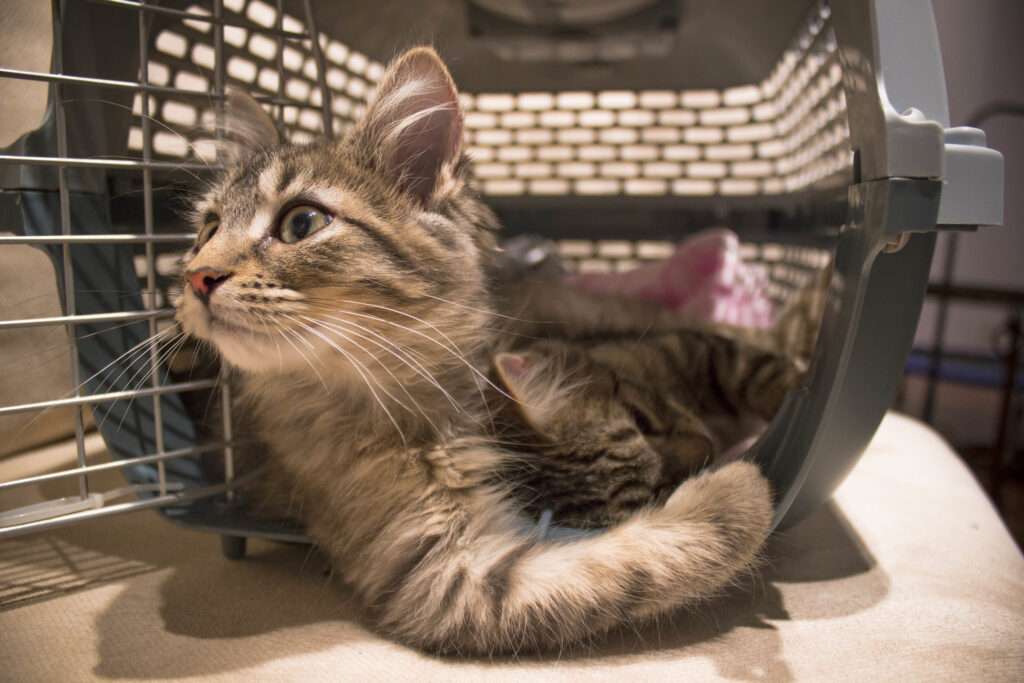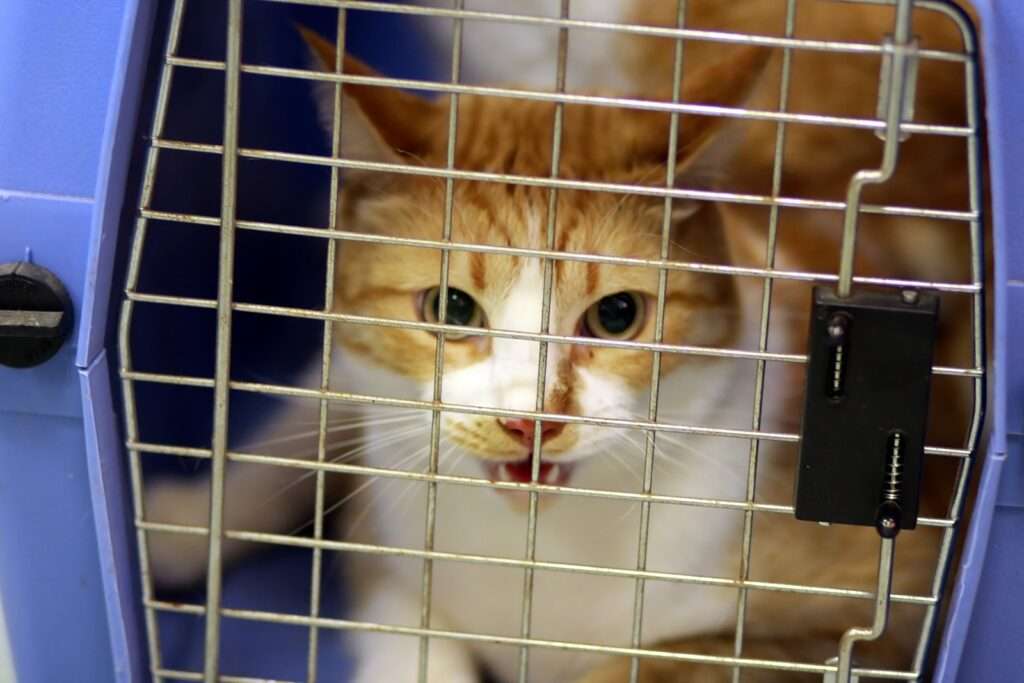How Long Can a Cat Stay in a Crate? The Ultimate Comprehensive Guide
You wake up one morning, and your feline friend is in need of a trip to the vet. Or maybe you’re trying to teach your new kitten some house rules, and a little confinement is in order. The question that often crosses your mind is, “How long can a cat stay in a crate?” Understanding the nuances of feline comfort and safety in these situations is paramount.
At BarkLikeMeow, we know that your cat’s well-being is your top priority, and the use of crates is often necessary for various purposes. But just how long is too long? This guide is your compass in navigating the world of cat crates, ensuring your furry family member remains content and secure while they’re confined. So, let’s embark on this journey together, understanding when and how to use crates to keep your cat happy, healthy, and comfortable.
The Purpose of Crates for Cats

Before we dive into the complexities of crate duration, let’s first explore why cat crates are essential tools for pet parents. While they might not be a cat’s first choice for hangout spots, crates serve several vital purposes in their lives. Here are some reasons why cat owners find themselves relying on these confinement solutions:
- Training: Crates can be invaluable in housebreaking your cat or teaching them essential behaviors. They provide a safe, controlled environment for training exercises, which are crucial for both kittens and adult cats.
- Safety: Sometimes, our cats need a little protection. Whether it’s during a home renovation, a visitor with allergies, or when introducing a new pet, a crate can offer a secure sanctuary where your cat can feel safe.
- Travel: When you need to take your feline friend on a journey, a crate is a must. Whether it’s a trip to the vet, a cross-country move, or a family vacation, a well-prepared crate ensures your cat’s safety and comfort while on the move.
- Medical Purposes: In the unfortunate event of an illness or post-surgery recovery, your cat may need to spend some time in a crate. This helps in monitoring their condition and preventing them from overexerting themselves during the healing process.
As you can see, crates have various applications in the life of a cat owner. However, the key is to strike a balance and use them responsibly, respecting your cat’s nature and preferences while ensuring their well-being. In the following sections, we’ll delve into understanding your cat’s natural instincts and how they respond to confinement, setting the stage for responsible crate use.
Understanding Your Cat’s Nature
Cats, those enigmatic creatures we adore, are known for their independence and unique personalities. To determine how long a cat can stay in a crate comfortably, it’s essential to understand their innate nature. Cats are naturally inclined toward freedom and solitude, often preferring to roam as they please. This independent spirit is at the heart of what makes them such fascinating companions.
Your cat’s inclination for freedom means they may not take kindly to being confined for extended periods. While crates have their place, it’s crucial to respect their need for independence and space. To do this, consider the following aspects of your cat’s nature:
- Territorial Instincts: Cats are territorial by nature. Crates can sometimes make them feel as though they’re encroaching on their territory, which might lead to stress or discomfort.
- Social Interaction: Cats vary in their social needs. Some adore human interaction and companionship, while others prefer solitude. Understanding your cat’s preferences can help you gauge their tolerance for crate time.
- Stress Sensitivity: Cats are sensitive creatures. Sudden changes, loud noises, or unfamiliar surroundings can trigger stress. Be mindful of how these factors might affect your cat’s response to being crated.
Factors Influencing Crate Time
Now that we’ve explored the essence of your cat’s nature, it’s time to consider the factors that influence how long they can stay in a crate comfortably. The duration of crate time is not a one-size-fits-all equation and depends on various variables:
- Age and Temperament: Kittens, adult cats, and senior cats have different needs and tolerances for confinement. Young kittens may have more energy and shorter attention spans, while older cats may require more rest. Similarly, a cat’s temperament plays a role; some cats are naturally more patient and adaptable.
- Health and Medical Issues: Cats recovering from surgery or managing a chronic condition may need more extended periods of confinement. Your veterinarian will provide guidance on how to use crates in these situations to ensure your cat’s health and safety.
- Training Progress: The stage of crate training your cat has reached is a significant determinant of how long they can stay in a crate. Beginners will require shorter durations, while cats accustomed to crates might tolerate longer periods.
- Individual Preferences: Just like people, each cat is unique. Some cats might be more amenable to crate time, while others might struggle with it. Pay attention to your cat’s reactions and adjust crate time accordingly.
In our next sections, we’ll delve into the art of crate training for cats, ensuring that the process is as smooth and stress-free as possible. Responsible and patient training can significantly influence how your cat views their crate, making it a positive space rather than a source of anxiety.
Crate Training for Cats
Crate training is a fundamental step in acclimating your feline friend to their temporary confinement space. When done right, it can transform the crate from a dreaded space into a secure and comfortable retreat. Here’s a step-by-step guide to ensure a smooth crate training experience:
- Introduction to the Crate: Begin by making the crate an enticing and familiar place. Place your cat’s bedding, toys, or treats inside the crate, allowing them to explore at their own pace. Keep the door open initially, so they can come and go freely.
- Positive Associations: Encourage your cat to associate the crate with positive experiences. Offer treats or playtime near the crate to create a sense of reward and security. Gradually lead them inside the crate using these positive reinforcements.
- Gradual Confinement: Once your cat feels comfortable entering the crate, begin closing the door for short periods. Start with just a few minutes and gradually extend the time as they grow more accustomed to confinement. Observe their behavior and ensure they remain calm.
- Lengthening Crate Time: As your cat adapts to being in the crate, you can increase the duration of their stays. However, always monitor their comfort level. If your cat shows signs of stress or discomfort, it’s essential to backtrack and take smaller steps to avoid overwhelming them.
Safety Precautions for Cats in Crates
Ensuring your cat’s safety and well-being during crate time is paramount. Here are some important safety precautions to keep in mind:
- Choosing the Right Crate Size and Type: The crate should be large enough for your cat to stand, turn around, and lie down comfortably. If your cat is still growing, opt for a crate that allows for size adjustments. Different crate types, such as wire crates or plastic carriers, suit different purposes, so choose one that fits your needs.
- Ventilation and Proper Airflow: Adequate airflow is crucial to your cat’s comfort. Make sure the crate has good ventilation, preventing it from becoming too hot or stuffy. Mesh sides or ventilation holes can facilitate proper airflow.
- Ensuring a Comfortable Environment: Place a soft, familiar blanket or bedding inside the crate to make it cozy and inviting. Cats often appreciate having their scent nearby, which can have a calming effect. Ensure there are no sharp edges or hazards within the crate.
- Regular Checks and Cat’s Comfort Indicators: While your cat is in the crate, keep an eye on them through the crate’s openings. Ensure they are relaxed and comfortable. Look for signs of stress, such as excessive meowing, pacing, or excessive grooming, and take action if needed.
Crate training, when combined with these safety measures, can help create a positive and secure space for your cat. Remember, the ultimate goal is to make the crate a place where your cat feels at ease, not stressed or anxious. This takes time and patience, so proceed at your cat’s pace and respect their needs and preferences.
How Long Can a Cat Stay in a Crate?
Determining the ideal duration for your cat’s stay in a crate is a crucial aspect of responsible crate usage. Here, we offer some general guidelines for different life stages of cats:
- Kittens: Kittens have boundless energy, but they also need plenty of rest. For kittens, crate time can typically range from 30 minutes to a few hours, allowing them to nap, recharge, and learn boundaries.
- Adult Cats: Adult cats can tolerate more extended periods in a crate, ranging from 2 to 4 hours. However, it’s crucial to remember that individual temperament plays a significant role. Some cats may be more patient than others.
- Senior Cats: Senior cats may need more frequent breaks and shorter periods in a crate, especially if they have health issues. Crate time for senior cats may vary from 1 to 3 hours, depending on their specific needs.
Balancing crate time with social interaction, exercise, and mental stimulation is essential. Ensure your cat gets time outside the crate to stretch their legs, play, and explore. Adequate attention to their needs outside of the crate will make their time inside it more comfortable and stress-free.
Traveling with Cats in Crates
Traveling with your cat in a crate requires special preparation and care. Whether you’re heading to the vet or embarking on a road trip, follow these tips for a smooth and safe travel experience:
- Preparation is Key: Before your journey, ensure your cat is accustomed to their travel crate. Familiarity with the crate will make them feel more at ease during travel.
- Proper Ventilation: Adequate ventilation is critical. Make sure the crate allows for proper airflow and never leave your cat in a hot car, even with the windows cracked.
- Secure the Crate: In the car, secure the crate with a seatbelt or use a pet car seat to keep your cat’s crate stable and safe.
- Comfort Items: Place familiar bedding and toys in the crate to provide comfort and a sense of security. Familiar scents can help calm your cat during the journey.
- Avoid Overfeeding: While traveling, avoid feeding your cat a large meal right before departure to prevent motion sickness. Offer a small meal a few hours in advance.
- Stops and Breaks: Plan for breaks during long journeys to allow your cat some time outside the crate to stretch, eat, and use the litter box.
- Stay Calm and Reassuring: Speak to your cat in soothing tones during travel and offer treats or affection to reassure them. Keeping a calm demeanor can help your cat feel less stressed.
By following these travel tips and considering your cat’s comfort, you can make traveling in a crate a less daunting experience for both you and your feline companion. Whether it’s a short drive to the vet or a more extended adventure, responsible crate usage ensures your cat’s well-being while on the move.
Medical and Recovery Crating
There are times in your cat’s life when medical issues or post-surgery recovery require confinement in a crate. While it’s not their preference, it’s crucial for their well-being. Here’s how to make this experience as comfortable as possible:
- Consult Your Veterinarian: Seek your vet’s advice regarding the necessity and duration of crate time during your cat’s recovery. They will provide guidelines specific to your cat’s condition.
- Comfort and Proximity: Place the recovery crate in a quiet, low-traffic area of your home. Ensure it’s comfortable with soft bedding, and keep it close to you, so your cat doesn’t feel isolated.
- Monitor Recovery: Keep a close eye on your cat during this time. Watch for any signs of discomfort or complications. Be prepared to adjust crate time and seek professional advice if necessary.
- Medication and Nutrition: Administer any prescribed medications and provide a balanced diet as recommended by your veterinarian to aid in a smooth recovery process.
- Gentle Socialization: Spend time sitting near the crate to offer your presence and soothing words. Be mindful of your cat’s need for companionship during their recovery.
Alternatives to Crating
While crates serve essential purposes in your cat’s life, there are alternatives to consider that might be more comfortable for your furry friend. These alternatives can help maintain their freedom and independence:
- Cat-Proofing Your Home: Make your living space safe for your cat by removing hazards, such as toxic plants or small items that could be ingested. Block off areas where your cat shouldn’t go.
- Designated Cat Rooms: Create a room in your home where your cat can roam freely, equipped with their essentials like a litter box, food, water, toys, and cozy places to rest. This provides a balance between confinement and freedom.
- Playpens: Consider using a cat playpen to restrict your cat’s movements when needed. These provide more room than a crate and can be used for short-term confinement while still allowing some freedom.
- Supervised Playtime: Engage in interactive play and supervised exploration with your cat. This can fulfill their need for exercise and mental stimulation without the need for confinement.
- Cat Enclosures: If you have outdoor space, consider a cat enclosure or catio. These outdoor enclosures allow your cat to experience the outdoors safely.
Understanding when to use crates and when to explore alternatives is a crucial part of responsible cat ownership. By providing your cat with safe and stimulating environments, you can strike a balance between their natural instincts and the need for occasional confinement.
As cat owners, our primary goal is to keep our furry friends happy, healthy, and secure. Whether you opt for crate training, traveling in a crate, or alternatives to confinement, always prioritize your cat’s well-being and comfort above all else. This balanced approach ensures a harmonious life with your beloved feline companion.
Signs of Stress or Discomfort

Cats are masters at masking their feelings, but they do give us subtle cues when they’re unhappy or stressed. Recognizing these signs is crucial for responsible crate usage and ensuring your cat’s well-being. Keep an eye out for these subtle indicators of stress or discomfort:
- Excessive Meowing: If your cat suddenly becomes vocal and meows persistently in the crate, it’s a sign of distress.
- Pacing or Agitation: Restless behavior, like pacing back and forth, may suggest your cat is anxious or uncomfortable.
- Excessive Grooming: Over-grooming can be a sign of anxiety or distress in cats. They may resort to this behavior when feeling stressed.
- Hiding: Cats often retreat and hide when they’re upset. If your cat tries to conceal themselves within the crate, it may indicate discomfort.
- Panting or Rapid Breathing: If your cat is breathing heavily, it’s a clear sign of distress. Ensure proper ventilation and reduce stressors to help alleviate this.
- Refusal to Enter the Crate: If your cat resists entering the crate despite previous positive associations, it may indicate their reluctance.
It’s essential to pay attention to your cat’s behavior and adjust crate time or circumstances accordingly if you notice any of these signs. Your cat’s comfort and well-being should always take precedence.
Real-Life Case Studies
Let’s take a moment to explore some real-life experiences of cat owners who have navigated the realm of crate usage responsibly. These case studies offer valuable insights into the world of cat crates and how different approaches can impact your feline companion.
Case Study 1: The Traveling Cat
Samantha, a seasoned traveler, regularly took her cat, Whiskers, on road trips. She followed our travel tips, ensuring Whiskers had a comfortable crate, proper ventilation, and soothing companionship during their journeys. Whiskers adapted beautifully to crate travel and felt secure on the road.
Case Study 2: The Recovering Cat
George had a senior cat, Luna, who needed surgery. Following the advice of their veterinarian, George prepared a cozy crate for Luna’s post-surgery recovery. He provided pain medication, monitored her closely, and ensured she was surrounded by familiar scents. Luna healed well and felt comfortable during her crate confinement.
These real-life scenarios highlight the importance of responsible crate usage and attentive care. Each cat’s needs and experiences are unique, emphasizing the significance of tailoring your approach to suit your cat’s individual personality and requirements.
By studying these case studies, you can gain inspiration and guidance on how to navigate the complexities of crate usage while prioritizing your cat’s happiness and well-being. Remember that your cat’s comfort and contentment are the ultimate goals in every decision you make as a dedicated pet parent.
Conclusion
In the world of feline care, crate usage is a valuable tool, but one that should always be wielded with care and consideration. Responsible crate usage is all about striking the right balance between the need for confinement and the freedom your cat cherishes. As you’ve learned in this guide, understanding your cat’s natural instincts, recognizing their signs of stress, and following best practices for crate training are all integral components of providing a safe, comfortable, and loving environment for your feline companion.
Remember that there is no one-size-fits-all answer to the question, “How long can a cat stay in a crate?” The answer depends on your cat’s age, temperament, and specific situation. The key is to remain attentive to your cat’s cues and adjust crate time accordingly.
As a pet parent, your cat relies on you to make informed decisions that prioritize their well-being. Whether you’re crate training, traveling, or assisting in recovery, your cat’s comfort and happiness should always be at the forefront of your considerations. By following the guidelines in this article and being in tune with your cat’s needs, you can create a positive and harmonious life for both you and your cherished feline companion.
Frequently Asked Questions
Can I leave my cat in a crate all day while I’m at work?
Leaving your cat in a crate all day is generally not recommended. Cats need ample space and mental stimulation. If you must crate your cat during your work hours, ensure frequent breaks, ample room for movement, and interactive toys to keep them engaged.
What if my cat refuses to enter the crate or is fearful of it?
Crate training should be gradual and positive. Use treats, toys, and familiar scents to make the crate a welcoming space. Take your time, be patient, and never force your cat into the crate.
How can I tell if my cat is stressed or uncomfortable in the crate?
Watch for signs such as excessive meowing, pacing, panting, hiding, or refusal to enter the crate. These are indications of stress or discomfort. Adjust crate time and conditions accordingly.
Are there any specific tips for traveling with a cat in a crate on an airplane?
When flying with your cat, ensure you comply with the airline’s regulations for pet travel. Use an airline-approved crate, provide proper ventilation, and make sure your cat is comfortable and secure during the journey.
Can I crate my cat overnight?
Crate use overnight depends on your cat’s age, health, and personal preference. Many cats adapt well to overnight crate use, especially during the training phase. However, older cats or those with specific needs might be more comfortable outside the crate during the night.
Are there alternatives to crates for confining my cat when needed?
Yes, there are alternatives such as cat-proofing your home, creating designated cat rooms, using cat playpens, or providing supervised playtime. The choice depends on your cat’s specific needs and your living situation.
How do I clean and maintain the crate to ensure my cat’s comfort and health?
Regularly clean the crate by removing bedding and washing it. Wipe down the crate interior with pet-safe cleaners to prevent odor and ensure a hygienic environment for your cat.
What should I do if my cat resists the crate during travel or vet visits?
Patience and positive associations are key. Use treats, toys, and soothing words to reassure your cat. Gradual desensitization to the crate and associating it with positive experiences will help alleviate resistance.
Can I use a crate for multiple cats?
Crating multiple cats can be challenging, as it may lead to stress or aggression. If you must crate multiple cats, ensure adequate space, separate crates, and monitor their interactions carefully.
Is crate training a kitten different from crate training an adult cat?
Crate training is similar for both kittens and adult cats, but kittens may have shorter attention spans. Training sessions for kittens should be shorter and more frequent, with an emphasis on positive reinforcement.





